Written by Jess Daniels with photography by Paige Green
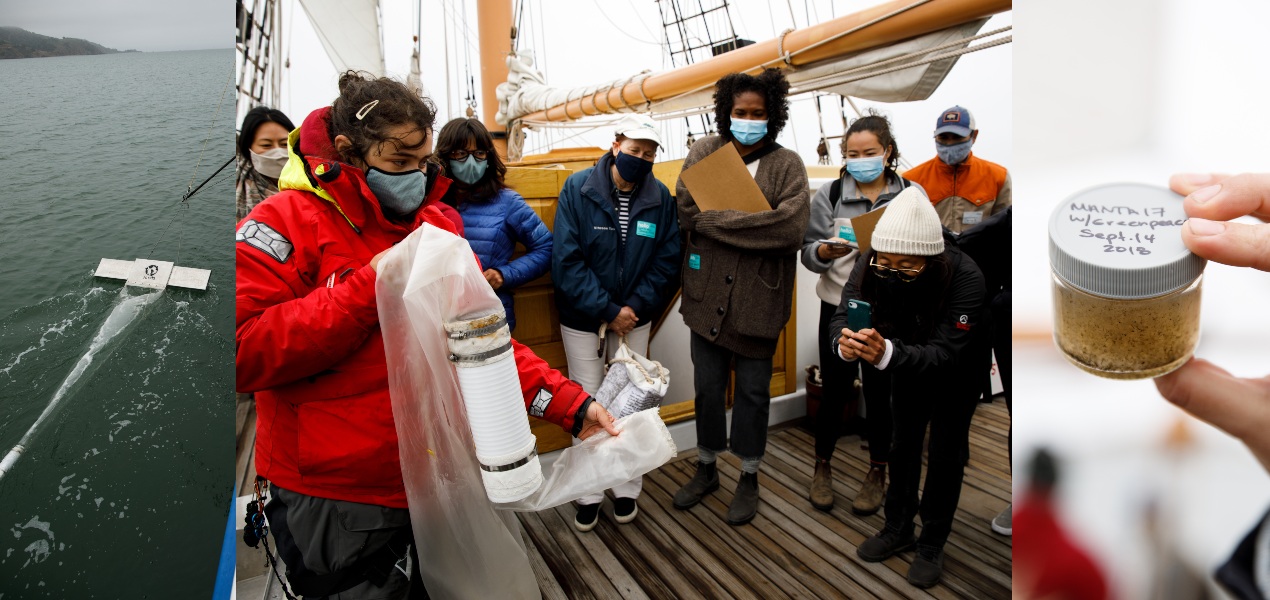
Earlier this month, we set sail on the San Francisco Bay with a small group of textile industry experts and ocean health advocates to discuss how fibers and fashion are impacting two of our planet’s largest carbon pools: soil and sea. The trip was organized by Materevolve, a consultancy led by textile scientist Krystle Moody Wood who has previously worked with Fibershed to develop Climate Beneficial Wool value chains, including the Cali Wool beanie by The North Face and the first run of Community Supported Cloth.
Getting out on the windy Bay offers a new vantage point: a 360-degree view of the densely populated Bay Area counties from Marin, to San Francisco, to the East Bay and South Bay cities and the bridges that connect them. We can see how our social and urban systems are enveloped by our watershed.
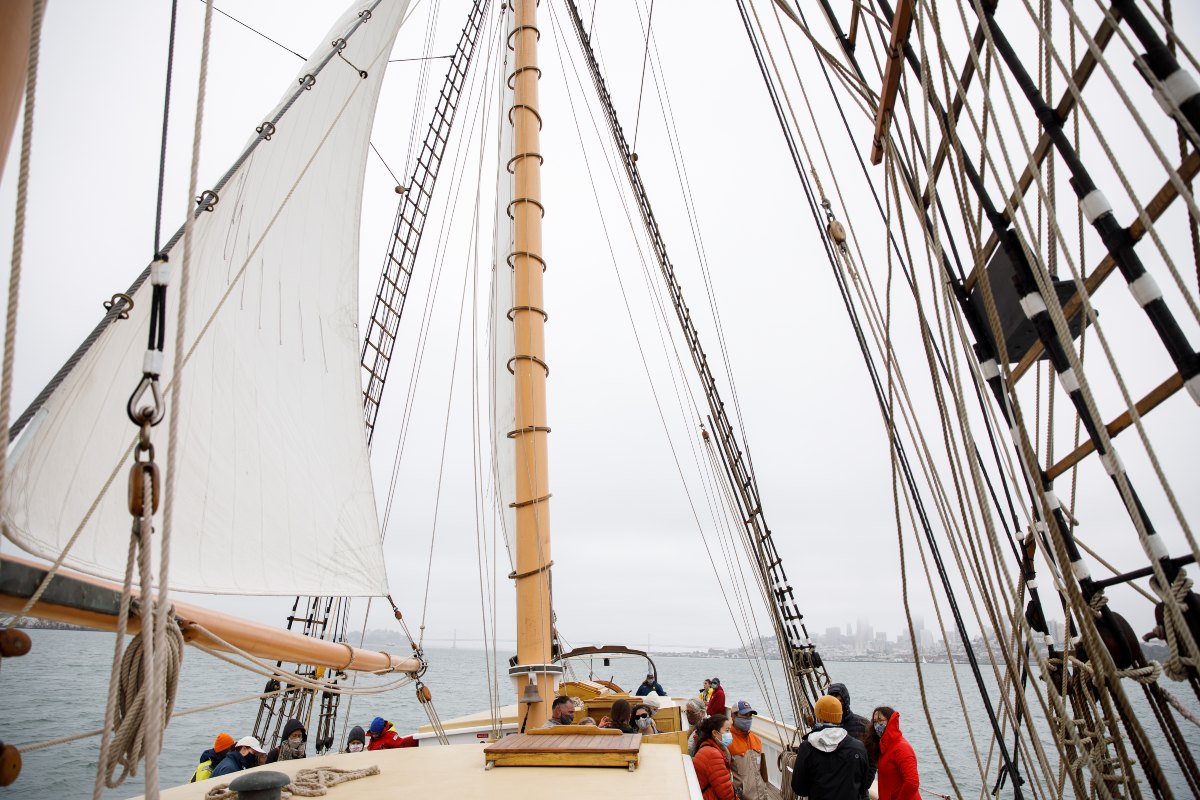
Aboard Call of The Sea’s Matthew Turner educational ship (powered by a hybrid electric motor), our group had the opportunity to experience ocean science firsthand: Carolynn Box, a lead researcher of the San Francisco Bay Microplastics study, introduced us to the manta trawl sampling tool. The manta trawl is a collection device that allows water to flow through and captures small particles and sediment in a fine mesh sleeve. Steve Kielar, Director of Education for Call of the Sea, launched the manta trawl overboard and we watched as it moved alongside the boat, creating a parallel stream in the waves.
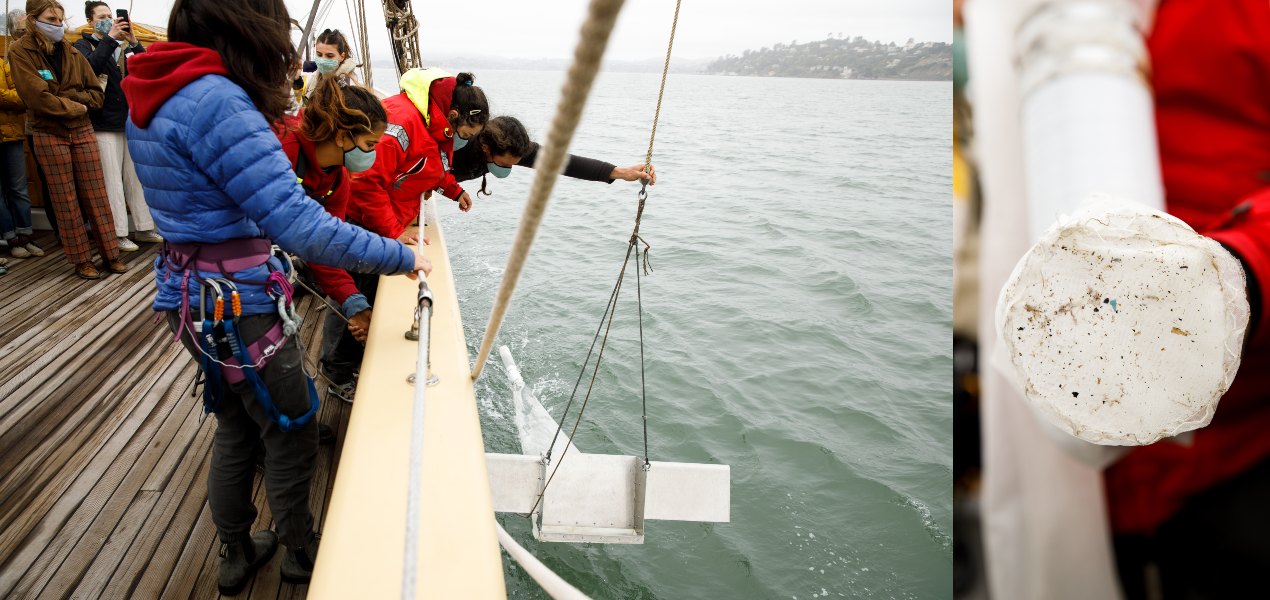
After several minutes in the sea, the manta trawl was pulled up and everyone gathered around to observe the sample. Microplastics, by definition, are often too small to see: they are tiny particles of plastic 5 millimeters or smaller, which enter the environment through human use. In particular, microfibers — the most abundant form of microplastics in the SF Bay — are typically smaller than a single strand of human hair. In the murky sample from the manta trawl, we could see several small plastic fragments, a signal of what likely lies beneath our observable range.
The trip was developed by Materevolve with support and collaboration from Italia Hannaway and the Sorci Family Foundation, and educational support from Fibershed. It brought together professionals across sectors who are connected by a common thread: how fiber systems impact the health of our oceans and waterways.
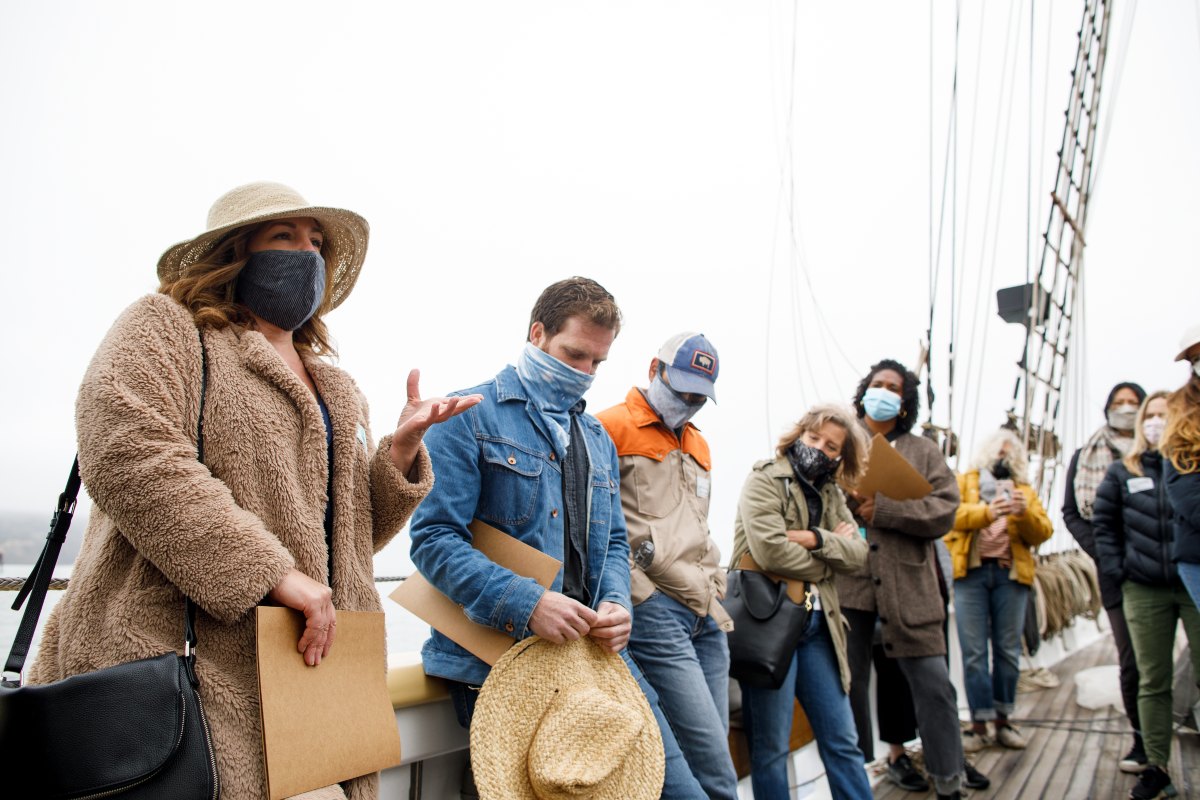
From brands and independent designers who focus on natural fibers, like Coyuchi, Aliya Wanek, Ambatalia/Non-disposable life, and Italia A Collection, to educators who have worked in fashion design curricula at California College of the Arts and the Fashion Institute of Design and Merchandising, the group included sustainability-minded creatives keen to dive deeper into these issues. Locally-based larger brands and collectives were represented too, including Levi’s, Everlane, as well as the Sustainable Fashion Alliance.
It is well known that the fashion industry is a major contributor to global carbon emissions, even if the exact climate impact has been challenging to capture — a recent estimate calculated a total of 2.1 Billion tons of greenhouse gas emissions in 2018 alone, more than maritime shipping and international flights combined.
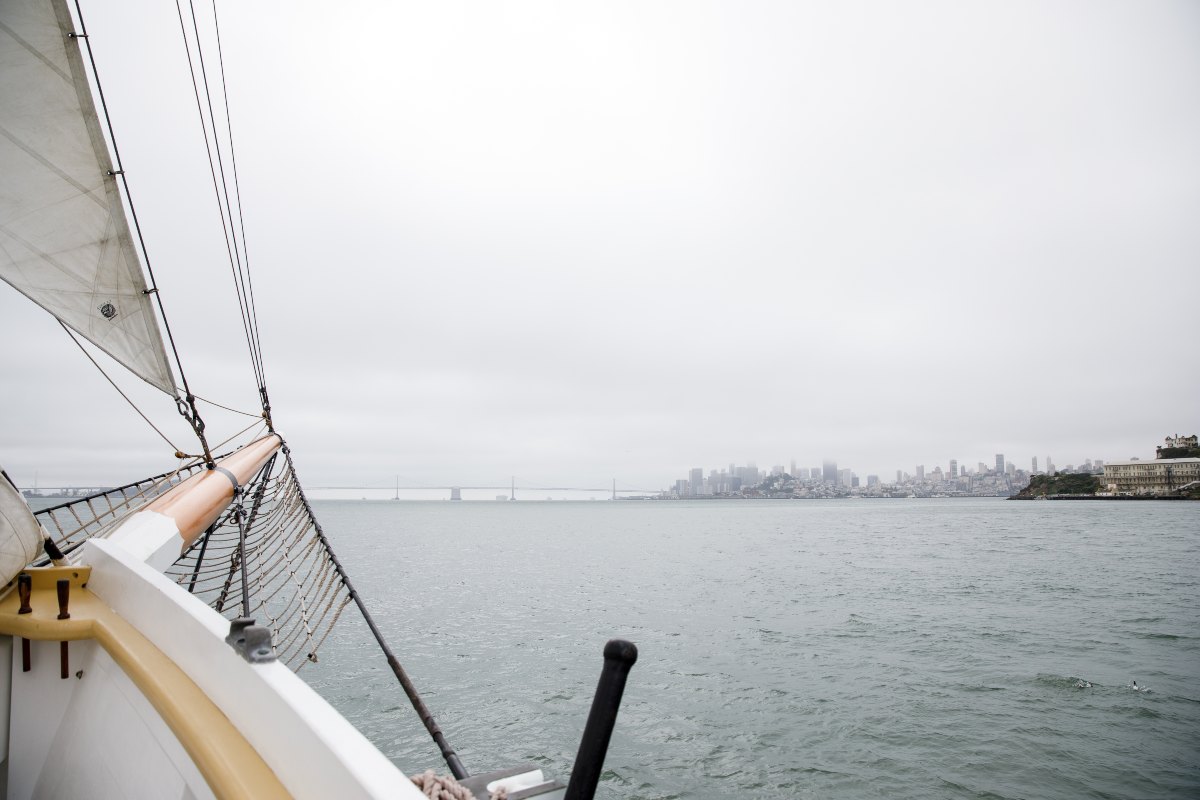
Oceans are the world’s largest carbon pool, meaning that a large amount is contained as dissolved carbon dioxide, as well as calcium carbonate in shells. Carbon cycles through the earth’s pools, and the ocean has become a major carbon sink, absorbing the excess greenhouse gasses that human activities create — like extracting fossil fuels and processing them into plastics for clothing. Unfortunately, the impacts to the ocean and marine ecosystems are devastating, including disrupted food webs, habitat loss, and changes for communities relying on a healthy ocean.
So, when we look at how microplastics are impacting aquatic ecosystems, it’s important to remember the context that the climate crisis is already disrupting the health of our oceans and marine life. With roughly 60% of current fiber production being synthetics derived from fossilized carbon like oil and gas, that means that the majority of the world’s textiles are shedding microplastics over the course of their lifetimes. This microplastic microfiber fragmentation is an area of growing concern, and requires solutions at every level, from textile production to clothing care to waste disposal and water treatment.
At the Materevolve event, we heard from advocacy and policy experts and scientists about emerging frameworks for addressing microplastic pollution. Scott Coffin, PhD, from the State Water Board, shared how California will be the first governmental body to require testing and reporting of microplastic levels. Noelle McHenry from SF Department of the Environment, noted that the city has been scoping filtration technologies that could be used in pilot programs for washing machines in residential and commercial settings.

Unfortunately, filtering microplastics out of water is a tailpipe solution that does not address the source of the pollution and its harms. Joanne Brasch, PhD, from the California Product Stewardship Council was on board for the trip, and highlighted how textiles can be part of producer responsibility programs. This year, CPSC is working to develop and bring a set of recommendations on textile policy to the California Legislature that will extend textile producer responsibility to the care and end of life of textiles, including addressing impacts of textiles on plastic microfiber pollution.
During the trip’s educational breakout groups, Fibershed and partners shared our vision for systemic solutions that re-envision our textile system and have the ability to actually regenerate the health of our soil and sea. Executive Director Rebecca Burgess shared with the group that “fossil carbon has brought many parts of modern life to us, and it’s time to make some shifts. We need everybody to join in this” and led small-group discussion about the carbon cycle and how a soil-to-soil framework can reshape our carbon impact.
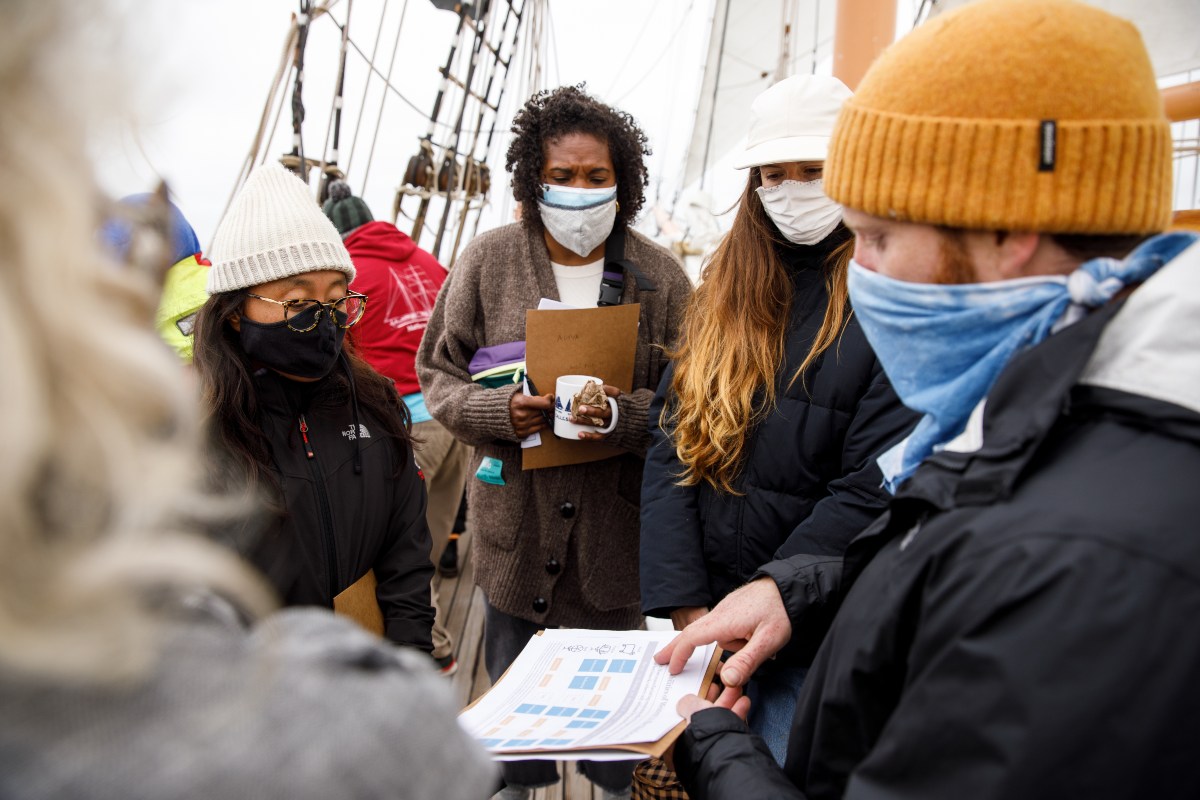
“I loved learning about the concept of the “fibershed,” it’s helping me take a hard look at what agricultural practices and fibers are being promoted or disincentivized” shared Kaitlyn Kalua, Policy Manager at California Coastkeeper Alliance. In a small-group session led by Nicholas Wenner, participants learned how Fibershed’s Regional Fiber Manufacturing Initiative is modeling the technical and financial resources needed to make use of the abundance of natural fiber to activate regional supply networks. Materevolve founder Krystle Moody Wood noted that “there’s such power in thinking and working regionally… we think [everyone aboard] plays an important role in building regenerative systems.”
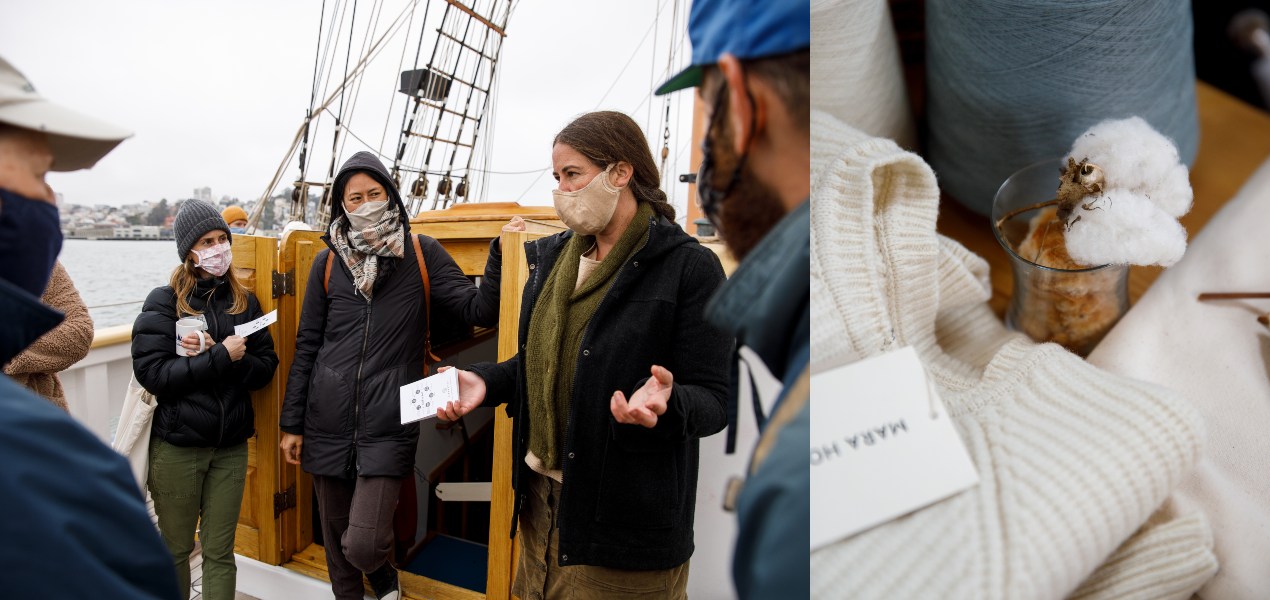
In the ship’s cabin, a small table showcased how these systems are moving from vision to viable products, including a sweater produced and yarns produced through the Climate Beneficial Fiber Pool, and cotton fabric developed by California Cloth Foundry. Derek Azevedo from Bowles Farming Company joined the voyage and shared with participants how and why their team is trialing carbon farming practices to build soil health on cotton fields in the San Joaquin Valley.
Educational stations led by Materevolve’s Carolynn Box and Ecocity Builders Executive Director Kirstin Miller underscored the localized impacts of our global fiber system. Sharing preliminary data from the Closet Survey for Climate & Ocean Health, Kirstin pointed out that an average of 55% of the clothing in our wardrobes is contaminated with synthetic fibers, and that we can visualize the lifecycle impacts by depicting how fibers are flowing from source and clothing production, through our wardrobes, to the “sinks” of water, land, and landfill. Carolynn brought this pathway to life with murky water samples that were part of the San Francisco Bay microplastics research project, and an animated map created by UC Davis Center for Watershed Sciences Senior Researcher Rusty Holleman that charts the flow of different microplastics from the Bay into the marine ecosystems:
With all the evidence and direct experience of the day spent learning about microplastics pollution, it’s clear that the fashion and textile industry needs to change course. Yet too many fashion sustainability efforts continue to position plastic and synthetic fibers as solutions for the sector’s environmental footprint. Research shows that recycled plastics produce and shed more microfibers, which means that efforts to “clean up the ocean” by capturing plastic waste and making it into garments and durable goods, are in fact only making the pollution smaller and harder to clean up.
The good news is that choosing natural fibers is an upstream solution. Fibers like cotton, wool, alpaca, and linen provide time-honored textiles for our homes and wardrobes and contribute to alleviating our modern crises. When designers, brands, and makers connect with and support the land stewards producing natural fibers, we see how fibers can be part of farming and ranching systems that restore ecosystem health and are even Climate Beneficial. In the Northern California Fibershed alone, we estimate that carbon farming practices on producer member landscapes could sequester 5 Billion pounds of carbon — reducing the burden on ocean and marine systems while improving plant and soil health.
Our goal is to continue weaving together these problem and solution sets so that the fashion and textile industry sees how addressing microplastic pollution is an opportunity to broaden the lens and shift their impact toward a force for regenerating community and ecosystem health.
